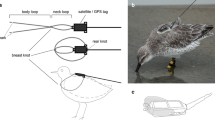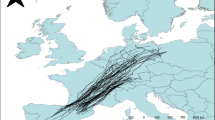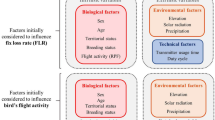Abstract
The development of increasingly small devices for the satellite tracking of small birds allows us to explore aspects of avian migration that have never been studied before. Here, we provide the results of using 12- and 9.5-g platform transmitter terminals (PTTs) to track game birds of 300–385 g. Attaching PTTs to 20 Woodcocks (Scolopax rusticola), wintering in Spain from 2006 to 2012, allowed us to explore (1) migration strategies (timing, velocity and stopovers), (2) the identity of the breeding grounds; (3) inter-year site fidelity to wintering grounds. We provide details of the route, speed and timing of migration and the location of remote breeding sites that were unknown prior to this study. The departure from winter quarters (median date) was completed by 20 March. The spring migration period lasted 40 days, and our birds were found to travel from >5,000 to >10,000 km, with a mean total migratory speed (i.e., including stopovers) of 170 km/day. Woodcocks followed fairly direct routes of migration. Stopover duration tended to be shortened when birds were closer to their breeding areas, which were located further east than previously stated. The only bird that provided long-term data (>1 year) was observed to return to the same wintering area, suggesting high winter site fidelity. The use of small PTTs opens new research lines related to the study and management of small to medium-sized migratory birds.
Zusammenfassung
Solar/Argos PTT-Sender widersprechen Ringfundanalysen: In Spanien überwinternde Waldschnepfen brüten weiter östlich als bislang angenommen Die Entwicklung zunehmend kleinerer Geräte zur Satellitenverfolgung kleiner Vögel gestattet es uns, zuvor noch nie untersuchte Aspekte des Vogelzuges zu erforschen. Hier stellen wir die Ergebnisse vor, die wir mit 12 g- und 9.5-g-PTT-Sendern (Platform Transmitter Terminals) an 300–385 g schwerem Federwild erzielten. Die Ausstattung von 20 in Spanien überwinternden Waldschnepfen Scolopax rusticola mit PTT-Sendern ermöglichte uns zwischen 2006 und 2012 (1) die Erforschung von Zugstrategien (zeitlicher Ablauf, Zuggeschwindigkeit und Rastaufenthalte); (2) die Ermittlung der Brutgebiete; (3) die Bestimmung der Winterquartiertreue von Jahr zu Jahr. Wir liefern Einzelheiten bezüglich Route, Geschwindigkeit und Zeitverlauf des Zuggeschehens sowie der Lage entfernterer Brutgebiete, die vor dieser Studie nicht bekannt waren. Der Abzug aus den Winterquartieren (Datumsmittelwert) war am 20. März abgeschlossen. Der Frühjahrszug dauerte 40 Tage, und unsere Vögel legten dabei zwischen über 5,000 bis über 10,000 km zurück, bei einer mittleren Zuggeschwindigkeit (d. h. einschließlich Zwischenstopps) von 170 km pro Tag. Die Waldschnepfen nutzten relativ direkte Zugrouten. Tendenziell verkürzte sich die Rastdauer, wenn die Vögel näher an ihre Brutgebiete kamen, welche weiter östlich lagen als bislang angenommen. Der einzige Vogel, welcher längerfristige (>1 Jahr) Daten lieferte, kehrte ins selbe Winterquartier zurück, was eine hohe Treue zum Überwinterungsgebiet nahelegt. Der Einsatz kleiner PTT-Sender eröffnet neue Forschungsansätze für die Untersuchung und das Management kleiner bis mittelgroßer Zugvögel.




Similar content being viewed by others
References
Alerstam T, Lindström Å (1990) Optimal bird migration: the relative importance of time, energy and safety. In: Gwiner E (ed) Bird migration: the physiology and ecophysiology. Springer, Berlin, pp 331–351
Alerstam T, Hake M, Kjellen N (2006) Temporal and spatial patterns of repeated migratory journeys by ospreys. Anim Behav 71:555–566
Arroyo B, Guzmán JL (2010) Estudio inter-autonómico sobre la becada (Scolopax rusticola) en España. Instituto de Investigación de Recursos Cinegéticos (IREC), Ciudad Real
Bächler E, Hahn S, Schaub M, Arlettaz R, Jenni L, Fox JW, Afanasyev V, Liechti F (2010) Year-round tracking of small trans-saharan migrants using light-level geolocators. Plos ONE 5:e9566
Bairlein F (2001) Results of bird ringing in the study of migration routes. Ardea 89:7–19
Battley PF, Warnock N, Tibbitts TL, Gill RE, Piersma T, Hassell CJ, Douglas DC, Mulcahy DM, Gartrell BD, Schuckard R, Melville DS, Riegen AC (2012) Contrasting extreme long-distance migration patterns in bar-tailed godwits Limosa lapponica. J Avian Biol 43:21–32
Bauthian I, Gossmann F, Ferrand Y, Julliard R (2007) Quantifying the origin of Woodcock wintering in France. J Wildl Manag 71:701–705
Chernetsov N (2012) Passerine migration: stopovers and flight. Springer, Berlin
Cramp S, Simmons KEL (1983) Handbook of the Birds of Europe, the Middle East and North Africa, vol 3. Oxford University Press, Oxford
Ferrand Y, Gossmann F (1988) Repartition spatiale des Bécasses des bois sur leurs habitats nocturnes en Bretagne. In: Havet P, Hirons G (eds) 3ème Symposium Européen sur la Bécasse et la Bécassine, Paris, pp 53–59
Ferrand Y, Gossmann F (2009) La Bécasse des bois. Histoire naturelle, Saint-Lucien Effet de Lisière
Guzmán J.L. (2013). Factores que modulan la abundancia poblacional de la becada (Scolopax rusticola): implicaciones para su gestión y conservación.Universidad de Castilla La Mancha
Guzmán JL, Ferrand Y, Arroyo B (2011) Origin and migration of woodcock Scolopax rusticola wintering in Spain. Eur J Wildl Res 57:647–655
Hake M, Kjellén N, Alerstam T (2003) Age-dependent migration strategy in honey buzzards Pernis apivorus tracked by satellite. Oikos 103:385–396
Hidalgo S, Rocha G (2001) Distribución y fenología de la Becada Scolopax rusticola (Linnaeus, 1758) (Charadriiformes, Scolopacidae) durante la invernada en Extremadura. Zool Baet 12:37–48
Hobson KA, Van Wilgenburg SL, Guzman JL, Arroyo B (2013) Origins of juvenile Woodcock (Scolopax rusticola) harvested in Spain inferred from stable hydrogen isotope (delta H-2) analyses of feathers. J Ornithol 154:1087–1094
Hoodless AN (1995) Eurasia Woodcock. Br Birds 88:578–592
Hoodless AN, Coulson JC (1994) Survival rates and movements of British and continental woodcock Scolopax rusticola in the British Isles. Bird Study 41:48–60
Klaassen RHG, Strandberg R, Hake M, Olofsson P, Tottrup AP, Alerstam T (2010) Loop migration in adult marsh harriers Circus aeruginosus, as revealed by satellite telemetry. J Avian Biol 41:200–207
Kokko H (1999) Competition for early arrival in migratory birds. J Anim Ecol 68:940–950
Kristensen M, Tøttrup AP, Thorup K (2013) Migration of the common Redstart (Phoenicurus phoenicurus): a Eurasian songbird wintering in highly seasonal conditions in the West African Sahel. Auk 130:258–264
Machado AL, Brito JC, Medeiros V, Leitao M, Moutinho C, Jesus A, Ferrand Y, Goncalves D (2008) Distribution and habitat preferences of Eurasian woodcock Scolopax rusticola in S. Miguel island (Azores) during the breeding season. Wildl Biol 14:129–137
Martell MS, Henny CJ, Nye PE, Solensky MJ (2001) Fall migration routes, timing, and wintering sites of North American Ospreys as determined by satellite telemetry. Condor 103:715–724
Mellone U, López-López P, Limaña R, Piasevoli G, Urios V (2013) The trans-equatorial loop migration system of Eleonora’s falcon: differences in migration patterns between age classes, regions and seasons. J Avian Biol 44:417–426
Mendiburu A, Arizaga J (2010) Patrones de distribución espacial y temporal de la becada (Scolopax rusticola) en Gipuzkoa, durante el periodo de migración e invernada. Munibe 58:187–195
Newton I (2008) The migration ecology of birds. Academic, London
Onrubia A (2003) Chocha perdiz, Scolopax rusticola. In: Martí R, Del Moral JC (eds) Atlas de las aves reproductoras de España. DGCN-SEO/BirdLife, Madrid, pp 258–259
Onrubia A (2012) Chocha perdiz Scolopax rusticola. In: Atlas de las aves en invierno en España 2007–2010 (Ed SEO/BirdLife), Ministerior de Agricultura, Alimentación y Medio Ambiente-SEO/BirdLife Madrid, pp 260–261
Péron G, Ferrand Y, Gossmann F, Bastat C, Guénézan M, Gimenez O (2011) Escape migration decisions in Eurasian Woodcocks: insights from survival analyses using large-scale recovery data. Behav Ecol Sociobiol 65:1949–1955
Schmaljohann H, Buchmann M, Fox J, Bairlein F (2012) Tracking migration routes and the annual cycle of a trans-Sahara songbird migrant. Behav Ecol Sociobiol 66:915–922
Spina F, Volponi S (2008) Atlante della migrazione degli uccelli in Italia. vol 1 non-Passeriformi. ISPRA-MATTM, Roma
Stutchbury BJM, Tarof SA, Done T, Gow E, Kramer PM, Tautin J, Fox JW, Afanasyev V (2009) Tracking Long-distance songbird migration by using geolocators. Science 323:896
Tavecchia G, Pradel R, Gossmann F, Bastat C, Ferrand Y, Lebreton JD (2002) Temporal variation in annual survival probability of the Eurasian woodcock Scolopax rusticola wintering in France. Wildl Biol 8:21–30
Tøttrup AP, Klaassen RHG, Strandberg R, Thorup K, Kristensen MW, Jargensen PS, Fox J, Afanasyev V, Rahbek C, Alerstam T (2012) The annual cycle of a trans-equatorial Eurasian-African passerine migrant: different spatio-temporal strategies for autumn and spring migration. Proc R Soc Lond B 279:1008–1016
Wernham C, Toms M, Marchant J, Clark JA, Siriwardena GM, Baillie S (2002) The migration atlas: movements of the birds of Britain and Ireland. Poyser, London
Zwarts L, Bijlsma RG, van der Kamp J, Wymenga E (2009) Living on the edge: Wetlands and birds in a changing Sahel. KNNV, Zeist
Acknowledgments
This work was funded by: Regional Councils or Governments of Gipuzkoa, Cataluña, Baleares, Bizkaia and Navarra; FEDENCA, IREC (CSIC-University of Castilla-La Mancha), Microwave Telemetry Inc., Urdaibai Bird Center-Sociedad de Ciencias Aranzadi, Club de Cazadores de Becada (CCB), CAM. Thanks to the people who collaborated during the flied work, especially to the CCB members. Authorizations to capture, ring and mark Woodcocks with PTTs were provided by Regional Councils or Governments of: Asturias, Gipuzkoa, Cataluña, Baleares, Castilla y León, Andalucía, Galicia, Bizkaia and Navarra. I.V. Iljinsky and one more reviewer provided valuable comments that helped us to improve an earlier version of this work.
Author information
Authors and Affiliations
Corresponding author
Additional information
Communicated by N. Chernetsov.
Appendix
Appendix
Rights and permissions
About this article
Cite this article
Arizaga, J., Crespo, A., Telletxea, I. et al. Solar/Argos PTTs contradict ring-recovery analyses: Woodcocks wintering in Spain are found to breed further east than previously stated. J Ornithol 156, 515–523 (2015). https://doi.org/10.1007/s10336-014-1152-7
Received:
Revised:
Accepted:
Published:
Issue Date:
DOI: https://doi.org/10.1007/s10336-014-1152-7




